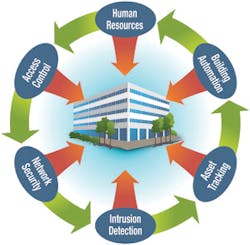Integrated Systems: Access Control Prediction Spells Opportunity
Access control will remain the largest and fastest growing U.S. electronic security segment through 2014, according to a recent study by industry analysts at the Freedonia Group. Oddly enough, this spells opportunity for some and a threat for others.
Corporate executives responsible for operational and financial efficiency will expect more from the security industry. In other words, more C-suite executives will demand access control systems integrate operationally and systematically to maximize their investments.
More than video and access control
To capture some of the predicted billions of dollars in growth for the electronic security market, security professionals must move beyond viewing integration as the mere convergence of systems such as video surveillance and access control. While the focus and purpose of this type of integration improves situational awareness and management of a facility’s security operations, executives now require more return on investments (ROI). Security providers must help them do more with less by maximizing building efficiency and reducing overhead.
Our research study “Bottom-Line Sustainability for Business: What’s Possible–And Profitable–About Intelligent Building Systems,” includes many industry leaders who agree. They say the greatest impact associated with the ongoing convergence of information systems and building automation systems (BAS) is an organization’s ability to enhance safety and security by better controlling who has access to critical data and facilities. As systems converge, building operators can monitor their buildings 24 hours a day, seven days a week, control access and recognize cost savings with the shutdown of non-necessary systems.
Rapid evolution of BAS is significantly impacting facilities and those responsible for safety and security. For a long time, security and BAS were developed separately, each focusing on individual technology developments and moving down the path of least resistance to market. But as buildings become “smarter,” and there continues to be a growing need to interconnect building facilities spread over different geographical locations for remote monitoring/analysis and control, the convergence of the two is inevitable.
Another level of integration
Let’s investigate the integration of access control with BAS. For those not familiar with BAS, this is a platform that collects data to control HVAC/lighting systems, provides continuous commissioning of these systems, identifies system deficiencies and provides measureable data to manage these systems. Integrated access control or RFID systems with BAS creates a platform to achieve even greater energy and operational efficiencies.
When entering or exiting a building, for example, the access control system identifies who and where you are in the facility. Integration with BAS unlocks this information and shares it across systems so lighting, temperature and other environmental settings adjust automatically. Energy efficiency associated with BAS integration is only one benefit, however. Each cycle of the electronic locking hardware is logged within BAS. Based on the manufacturer’s specifications on Mean Time To Failure (MTTF), a work order is initiated through CMMS to inspect or replace the unit. This improves preventative maintenance, which extends product life cycles and maximizes product effectiveness. Integrating access control systems into BAS also captures data used in calculating space utilization, which allows executives to make informed decisions on expansion needs.
How to integrate access control with BAS solutions
The most common communication protocols found in BAS integration applications are Modbus, Modbus TCP IP, BACnet, BACnet IP, LON, oBIX, ODBC, SQL and CSV files. BAS systems are designed to normalize data among many disparate systems through a single control platform to facilitate smarter building operations. No other systems found within a facility are capable of performing this function.
The good news is most access control manufacturers provide a Software Development Kit (SDK) or Application Programming Interface (API) for their systems. These allow an interface to be developed if one does not exist with an existing system. To integrate access control with BAS, an access control system must support an open communication protocol or one must be developed to bridge the gap between two systems currently not speaking the same language. If you are in the early stages of learning how to perform this level of integration, you may require assistance from an integrator with deep experience in getting disparate systems to talk to one another.
About the author: Joseph Feuling heads new business development for Environmental Systems Inc., with offices in Milwaukee and Chicago.
